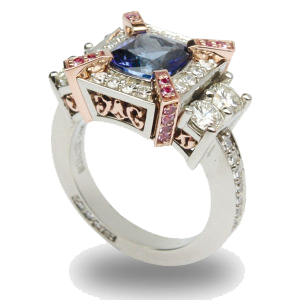
TAt its breathtaking best, tanzanite will look amazingly like Kashmir sapphire, exhibiting the rich, royal velvety blue hue that these gemstones are prized for, and at a fraction of the price. This exquisite gemstone is renowned for the wonderful combination of purple and blue hues, observed in different intensities within the same gemstone. Tanzanite is a trichroic gemstone, meaning that it gives off three different colors when viewed in different directions, or along the optic axis. The dominant colors being blue and violet will cause tanzanite to appear violet when exposed to incandescent light and blue when exposed to fluorescent light. The third less dominant color is reddish brown or bronze, which is rarely visible to the naked eye.
